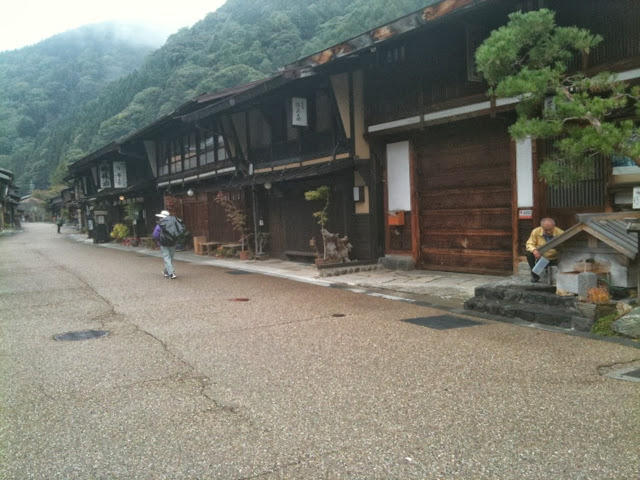You know it's been an exciting day when you get to talk about the wildlife on the trail and it includes monkeys!
While I admit he's difficult to see, that's a monkey sitting on a tree branch near the top of the photo, to the right of the large tree trunk. There were loads of monkeys here, in the trees & scampering across the trail, but always too fast to get a good shot.
But I get ahead of myself. Here's how we started our day at the minshuku (family inn, somewhat analogous to a B & B) in the preserved old post town of Narai, where we spent the night:
That's a breakfast place setting for one.
Most of you probably need a quick primer on the Nakasendo:
The Nakasendo was a highway that ran from Kyoto over an inland route before ending at Tokyo’s predecessor, Edo. Established in the 8th century it reached its zenith in the Edo period – a bustling highway for nobles, samurai, merchants, and commoners alike. In the past it would take travellers 18 to 20 days to walk the full length of the 533 km (330 mile) road, and there were 67 stages along the way. The introduction of the railway revolutionized Japan at the end of the 19th century and the old-style highways fell into disrepair.
Much of the original Nakasendo Highway is now gone, but there are still some sections of the old road that, along with connecting stage posts, have been preserved. (Source: http://www.nic-nagoya.or.jp/en/e/archives/648)
Our friend, Roxana Lewis, a fellow Sierra Club & Highpointer member who is also a travel agent, told us about this trip 2 years ago. It sounded fascinating, and we said 'sign us up'. And here we are!
As the description states, the entire Nakasendo road no longer exists - although we did meet a woman on the trail today who had walked the entire trail, from Tokyo to Kyoto, 17 years ago. That would include a lot of walking on modern roads, however, which were built over the old Nakasendo. And today was a good example of that. We left our inn and walked to the edge of town, where we continued on a preserved part of the Nakasendo, up a forested path to a pass (where we encountered the monkeys). The afternoon hiking, however, was along a modern road. Still interesting - it reminded me a lot of hiking in Great Briton, where you come to small villages every few miles.
I took lots of photos today, and they will give you a better feel for the hike:
Starting out - the preserved post town of Narai.
Dave placing a coin in shrine along the way.
Scenery along the modern road. I love the rural scene with the high-speed train rushing by in the background.
Tomoefaguchi Beautyspot. That's what the sign said in English (after about a paragraph of Japanese characters). It was beautiful - there is a spring falling down the rock wall you see.













Kiso-Fukushima is to the Kiso Valley what Baden Baden is to Germany. It is a premier hot spring destination. Consequently there are many Inns with fabulous onsen and fine cuisne.
ReplyDeleteWe hit a winner with IWAYA. When they assigned us private dinng room #25 with a long table and four chairs it was a super wow. The kimono clad server seemed to make the delivery of the courses even more ceremonial.
For cuisine this was my favorite.
I agree! This was my favorite inn for cuisine and onsen.
ReplyDeleteKoshinzuke was my favorite inn for ambience.
And Osaka was my favorite city - a very happening place!
Before we forget, Dave was given his Japanese name after this day of hiking, right?
ReplyDeleteMOAN-KU san.